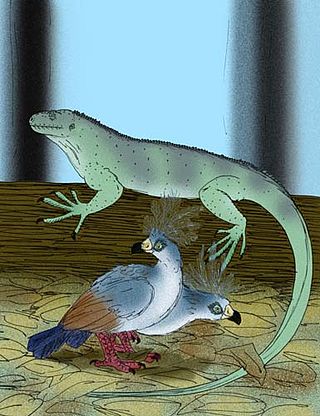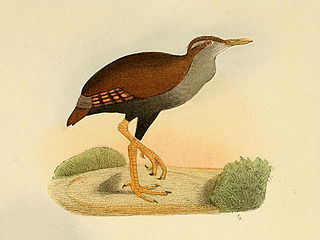Viti or Víti may refer to:

The upland moa is an extinct species of moa that was endemic to New Zealand. It is a ratite, a grouping of flightless birds with no keel on the sternum. It was the last moa species to become extinct, vanishing around 1500 CE, and was predominantly found in alpine and sub-alpine environments.

The New Zealand raven was native to the North Island and South Island of New Zealand but has been extinct since the 16th century. There were two subspecies: the North Island raven and the South Island raven. Another closely related species, the Chatham raven, occurred on the Chatham Islands.

Gallirallus is a genus of rails that live in the Australasian-Pacific region. The genus is characterised by an ability to colonise relatively small and isolated islands and thereafter to evolve flightless forms, many of which became extinct following Polynesian settlement.
The long-legged thicketbird is a small bird endemic to Fiji. The species is sometimes known as the long-legged warbler. It was formerly classified as the sole representative of the genus Trichocichla.

The Viti Levu giant pigeon or Fiji giant ground pigeon is an extinct flightless pigeon of Viti Levu, the largest island in Fiji. It was only slightly smaller than the dodo and Rodrigues solitaire and is the first giant flightless pigeon to be discovered on a Pacific island.
The long-billed wren is an extinct species of New Zealand wren formerly endemic to the South Island of New Zealand. It was the only species in the genus Dendroscansor. It shares the name "long-billed wren" with the Brazilian bird Cantorchilus longirostris.

The New Zealand bittern is an extinct and enigmatic species of heron in the family Ardeidae. It was endemic to New Zealand and was last recorded alive in the 1890s.

The bar-winged rail is an extinct species of bird in the family Rallidae. It was endemic to Fiji and was last collected ca 1890 in Viti Levu. The species was identified from twelve 19th century specimens, some of which are known to be in Boston, London and New York. The last unconfirmed sighting of this bird was in 1973.
Trevor Henry Worthy is an Australia-based paleozoologist from New Zealand, known for his research on moa and other extinct vertebrates.
The New Zealand stiff-tailed duck is an extinct duck species from New Zealand which is known only from subfossil remains. It was first described as a distinct species by Trevor H. Worthy in 2005.
Scarlett's duck is an extinct duck species from New Zealand which was closely related to the Australian pink-eared duck. The scientific name commemorates the late New Zealand ornithologist and palaeontologist Ron Scarlett who discovered the holotype in 1941. However, previously undescribed bones of the species found in 1903 were rediscovered in the Otago Museum in 1998. At least 32 fossil remains from deposits in Pyramid Valley, at Ngāpara in the South Island, and at Lake Poukawa in the North Island are in museum collections.
Hodgens' waterhen is an extinct rail species from New Zealand. Its name commemorates the Hodgen brothers who were owners of the Pyramid Valley swamp where the holotype was discovered. It reached a weight of 280 g and its wings were so reduced that it was unable to fly. It occupied a wide range of habitats, including open forest and grassland along riverbanks.

Volia is an extinct monospecific genus of mekosuchine crocodylian closely related to Mekosuchus and Trilophosuchus. Volia is known from a collection of largely fragmentary remains including skull bones and limbs recovered from the Voli Voli and Wainibuku Caves on Viti Levu (Fiji), with similar remains having been found on Naigani. It was around 2–3 metres (7–10 ft) long, making it the largest predatory animal on the island and subsequently most likely the apex predator of the Pleistocene ecosystems of Fiji. It may have fed on giant iguanas, flightless birds or even fish. Like its closest relatives, it may have been more terrestrial than today's crocodiles.
Scarlett's shearwater was an extinct species of seabird in the petrel family Procellariidae. Its common name commemorates New Zealand palaeontologist Ron Scarlett, who recognised the bird's subfossil remains represented a distinct species.

The snipe-rail is an extinct flightless rail endemic to the North Island of New Zealand. The species' name is derived from the Karamu Cave 21 kilometres (13 mi) from Hamilton where the holotype was discovered in 1954.
The Viti Levu scrubfowl, also known as the Fiji scrubfowl or lost megapode, is an extinct megapode that was endemic to Fiji. The epithet amissus, from Latin "lost", refers to its extinction. Subfossil remains were collected from the Udit cave at Wainibuku on the island of Viti Levu in October 1998 by Trevor Worthy, G. Udy and S. Mataraba, and described by Worthy in 2000. The holotype is held by the Museum of New Zealand.
Megavitiornis altirostris is an extinct, flightless, giant stem-galliform bird that was endemic to Fiji, it is the only known species in the genus Megavitiornis. Originally thought to be a megapode, more recent morphological studies indicate a close relationship with Sylviornis of New Caledonia, with both genera belonging to the family Sylviornithidae outside of the Galliformes crown group. It is likely that it became extinct through overhunting shortly after the colonisation of the Fiji Islands by humans.
Leiopelma auroraensis, known as the Aurora frog, is an extinct species of frog that was found in New Zealand. One subfossil of the Aurora frog has been discovered in the Aurora Cave, Fiordland, New Zealand. It measured about 60 mm from the snout to the vent. It is named after the Aurora Cave for where it was found. The other extinct New Zealand frogs are Markham's frog and Waitomo frog. Aurora frog probably was a local form that had evolved from the more widely distributed Markham's frog.
The Waitomo frog is an extinct species of the genus Leiopelma from New Zealand.







